The bee-eaters are a group of near-passerine birds in the family Meropidae. Most species are found in Africa and Asia but others occur in southern Europe, Australia, and New Guinea.
The bee-eaters are a fairly uniform group, morphologically. They share many features with related Coraciiformes such as the kingfishers and rollers, being large-headed (but not as large-headed as their relatives) short-necked, brightly plumaged and short-legged. Their wings may be rounded or pointed, with wing shape closely correlated with foraging habitat and migratory tendencies. Shorter, rounder wings are found on species that are sedentary and make shorter foraging flights in denser forests and reedbeds. Those with more elongated wings are more migratory. All the bee-eaters are highly aerial. They take off strongly from perches, fly directly without undulating, and are able to change directions quickly. Bee-eaters rarely hover, however.
The bills of bee-eaters are curved, long and end in a sharp point. The bill can bite strongly, particularly at the tip, and is used as a pair of forceps with which to snatch insects from the air and crush smaller ones. The short legs have weak feet, when moving on the ground its gait is barely more than a shuffle. The feet have sharp claws used for perching on vertical surfaces and also during nest excavation.
The plumage of the family is generally very bright and in most species dominated or at least partly green. The two carmine bee-eaters are mostly rosy coloured. Most of the Merops bee-eaters have a line through the eye and many have differently coloured throats and faces. The extent of the green in these varies from almost completely in the Green Bee-eater to barely any in the White-throated Bee-eater. Several species have long streamers in the tail, and in a few species these are ended with expanded spatulae. There is little visible difference between the sexes in most of the family. In several species the iris is red in the males and brown-red in the females.
The bee-eaters have an Old World distribution, occurring from Europe to Australia. The centre of diversity of the family is Africa, although a number of species also occur in Asia. Of the three genera, Merops, which has the majority of the species in the family, occurs across the entirely of the family's distribution.
Bee-eaters are fairly catholic in their habitat. Their requirements are simply an elevated perch from which to watch for prey and a ground substrate in which to dig their breeding burrow. Because their prey is entirely caught on the wing they are not dependent on any vegetation type. A single species is found inside closed rainforest, the Blue-headed Bee-eater, where it forages close to the ground in poor light in the gaps between large trees under the canopy. Six other species are also closely associated with rainforest, but do so in edge habitat in this environment; along rivers, in tree-fall gaps, off trees overhanging ravines or on emergent crowns above the main canopy.
A number of the bee-eaters are migratory. Species that breed in subtropical or temperate areas of Europe, Asia and Australia are all migrants. The European Bee-eaters that breed in southern Europe and Asia migrate to West and Southern Africa. Another population of the same species breeds in South Africa and Namibia; these birds move northwards after breeding. Several species of bee-eater, such as the White-throated Bee-eater, are intra-African migrants. The most unusual migration is that of the Southern Carmine Bee-eater, which has a three stage migration; after breeding in a band between Angola and Mozambique it moves south to Botswana, Namibia and South Africa before moving north to its main wintering grounds in northern Angola, Congo and Tanzania.
The bee-eaters are diurnal (active by day), although a few species may migrate during the night if the terrain on route is unsuitable for stopping or if they are crossing the sea. They are a highly social family. Pairs sitting together are often so close together that they touch (described as having an individual distance of zero). Groups may roost together in a row in such a fashion as well. Some species are highly gregarious in the non-breeding season, and many species are colonial in the breeding season as well.
The social structures of the White-fronted Bee-eaters have been described as "the most complex of any bird species anywhere in the world". The birds exist in stable colonies located on nesting cliffs, and have a stable structure year round. These colonies are composed of clans of two or three pairs, their helpers, and offspring. Within the colony the males alternate between guarding their mate and attempting to make forced copulations with other females. The females in turn attempt to lay eggs in their neighbour's nests. Within colonies some individuals also specialise in kleptoparasitism, stealing prey collected by other colony members. The colony's daily routine is to emerge from the nesting holes or roosting branches soon after dawn, preen and sun themselves for an hour, then disperse to feed. Feeding territories are broken down by clan, with the clan defending the territories from all others of the same species, including clans of the same colony. The clans return to the colony before dusk, and engage in more social behaviour before retiring for the night. Colonies are situated several hundred metres apart and have little to do with each other, although young individuals may disperse between colonies. As such these species can be thought to have four tiers of social kinship, the individual pair, the family unit, the clan and the colony as a whole.
Bee-eaters spend around 10% of their day on what are known as comfort activities. These include sunning themselves, dust bathing and water bathing. Sunning behaviour helps warm birds in the morning, reducing the need to use energy to raise the temperature. It also has a social aspect, as multiple birds adopt the same posture. Finally, it may help stimulate parasites in the feathers, making them easier to find and remove. Due to their hole-nesting bee-eaters accumulate a number of ectoparasites such as mites and flies. Together with sunning, bouts of dust bathing (or water bathing where available), as well as rigorous preening, keep the feathers and skin in good health. Bathing with water involves making shallow dives into a water body and then returning to a perch to preen.
The bee-eaters are almost exclusively aerial hunters of insect prey. Prey is caught either while in continuous flight or more commonly from an exposed perch where the bee-eater watches for prey. Smaller, rounder-winged bee-eaters typically hunt from branches and twigs closer to the ground, whereas the larger species hunt from tree tops or telegraph wires. One unusual technique often used by carmine bee-eaters is to ride the back of bustards. Prey can be spotted from a distance; European Bee-eaters are able to spot a bee 60 m away, and Blue-cheeked Bee-eaters have been observed flying out 100 m to catch large wasps. Prey is approached directly or from behind. Prey that lands on the ground or on plants is usually not pursued. Small prey may be eaten on the wing, but larger prey are returned to the perch to be beaten against the perch to kill them and break them up. Insects with poisonous stings are first smacked on the branch, then, with the eyes closed, rubbed to discharge the venom.
Bee-eaters consume a wide range of insects; beyond a few distasteful butterflies they consume almost any insect from tiny Drosophila flies to large beetles and dragonflies. At some point bee-eaters have been recorded eating beetles, mayflies, stoneflies, cicadas, termites, crickets and grasshoppers, mantises, true flies and moths. For many species the dominant prey item are stinging members of the order Hymenoptera, namely wasps and bees. In a survey of 20 studies the proportion of the diet made up by bees and wasps varied from 20% to 96%, with the average being 70%. Of these honeybees can comprise a large part of the diet – as much as 89% of the overall diet.
Bee-eaters are seasonally monogamous, and some species are monogamous over multiple seasons. Migratory species however are thought to form new pair bonds each breeding season. The courtship displays of the bee-eaters are rather unspectacular, with the exception of the "butterfly display" (where the wings of both sexes are held out while calling) of the White-throated Bee-eater. Most members of the family engage in courtship feeding, where the male presents prey items to the female, and such feeding can account for much if not all of the energy females require for egg creation.
Like almost all Coraciiformes the bee-eaters are cavity nesters. In the case of the bee-eaters the nests are burrows dug into the ground, either into the sides of earth cliffs or directly into level ground. Both types of nesting site are vulnerable, those on level ground are vulnerable to trampling and small predators, whereas those in cliffs, which are often the banks of rivers, are vulnerable to flash floods, which can wipe out dozens or hundreds of nests. Many species nest either on cliffs or on level ground but prefer cliffs, however the Böhm's Bee-eater always nests on level ground. The burrows are dug by both birds in the pair as well as any helpers that have joined the pair. The soil or sand is loosened with jabs of the sharp bill, then the feet are used to kick out the loose substrate. There may be several false starts where nests are dug partway before being abandoned; in solitary species this can give the impression of colonial living even when they are not. The process of nest building can take as long as twenty days to complete, during which the bill can be both blunted and shortened. Nests are generally used only for a single season and are rarely used twice by the bee-eaters, but abandoned bee-eater nests may be used by a host of birds, snakes and bats as shelter and breeding places.
Bee-eaters may nest as single pairs, loose colonies or dense colonies. Smaller species tend to nest solitarily, while medium sized species do so in the smaller colonies and larger and migratory species nest in large colonies that can number in the thousands. In some instances colonies may contain more than one species of bee-eater.
Africa Wild Bird Book
Family Meropidae (Bee-eaters) Index
Family Meropidae (Bee-eaters)
Merops hirundineus Swallow-tailed Bee-eater 445
Merops pusillus Little Bee-eater 444
Merops variegatus Blue-breasted Bee-eater
Merops bullockoides White-fronted Bee-eater 443
Merops albicollis White-throated Bee-eater 917
Merops boehmi Böhm's Bee-eater 442
Merops persicus Blue-cheeked Bee-eater 440
Merops superciliosus Olive Bee-eater, Madagascar Bee-eater 439
Merops apiaster European Bee-eater 438
Merops nubicoides Southern Carmine Bee-eater 441
Merops hirundineus Swallow-tailed Bee-eater 445
Merops pusillus Little Bee-eater 444
Merops variegatus Blue-breasted Bee-eater
Merops bullockoides White-fronted Bee-eater 443
Merops albicollis White-throated Bee-eater 917
Merops boehmi Böhm's Bee-eater 442
Merops persicus Blue-cheeked Bee-eater 440
Merops superciliosus Olive Bee-eater, Madagascar Bee-eater 439
Merops apiaster European Bee-eater 438
Merops nubicoides Southern Carmine Bee-eater 441
- Mel
- Global Moderator
- Posts: 26737
- Joined: Sat May 19, 2012 12:31 pm
- Country: Germany
- Location: Föhr
- Contact:
Swallow-tailed Bee-eater
445. Swallow-tailed Bee-eater Merops hirundineus (Swaelsterbyvreter)
Order: Coraciiformes. Family: Meropidae
Description
19-22 cm. The only bee-eater in the region to have a forked tail. Green chest and belly, separated by a blue band from the yellow throat. Tail blue and rather deeply forked.
Juvenile's underparts are completely green.
Distribution
Locally common in Namibia, Botswana, Zimbabwe, Mozambique and northern South Africa.
Habitat
Generally prefers arid woodland and savanna, especially on Kalahari sand, but occurs widely.
Diet
Exclusively eats insects, especially bees. It usually spots its prey from low perches, rapidly flying at the insect once it has been located. It kills its prey by repeatedly banging it against the perch. If it is venomous, the sting is rubbed against its perch until all the venom has been secreted.
Breeding
Unlike the larger Bee-eaters it is a solitary breeder. Both sexes excavate the nest, which consists of a short tunnel widening into an egg chamber. It is usually dug into sandbanks or riverbanks. Egg-laying season is usually from October-February, peaking from September-November. It lays 2-4 spherical, white eggs, at one day intervals.
Call
High-pitched piping kweep kweepy buzz, kweep. Listen to Bird Call.
Status
Common resident.
Order: Coraciiformes. Family: Meropidae
Description
19-22 cm. The only bee-eater in the region to have a forked tail. Green chest and belly, separated by a blue band from the yellow throat. Tail blue and rather deeply forked.
Juvenile's underparts are completely green.
Distribution
Locally common in Namibia, Botswana, Zimbabwe, Mozambique and northern South Africa.
Habitat
Generally prefers arid woodland and savanna, especially on Kalahari sand, but occurs widely.
Diet
Exclusively eats insects, especially bees. It usually spots its prey from low perches, rapidly flying at the insect once it has been located. It kills its prey by repeatedly banging it against the perch. If it is venomous, the sting is rubbed against its perch until all the venom has been secreted.
Breeding
Unlike the larger Bee-eaters it is a solitary breeder. Both sexes excavate the nest, which consists of a short tunnel widening into an egg chamber. It is usually dug into sandbanks or riverbanks. Egg-laying season is usually from October-February, peaking from September-November. It lays 2-4 spherical, white eggs, at one day intervals.
Call
High-pitched piping kweep kweepy buzz, kweep. Listen to Bird Call.
Status
Common resident.
God put me on earth to accomplish a certain amount of things. Right now I'm so far behind that I'll never die.
- Mel
- Global Moderator
- Posts: 26737
- Joined: Sat May 19, 2012 12:31 pm
- Country: Germany
- Location: Föhr
- Contact:
Swallow-tailed Bee-eater Photos
445. Swallow-tailed Bee-eater Merops hirundineus
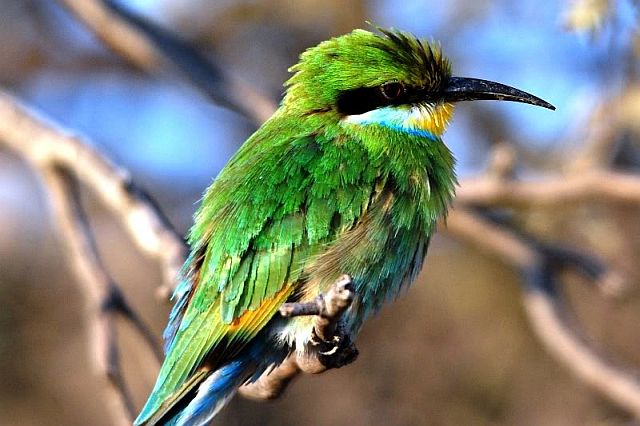
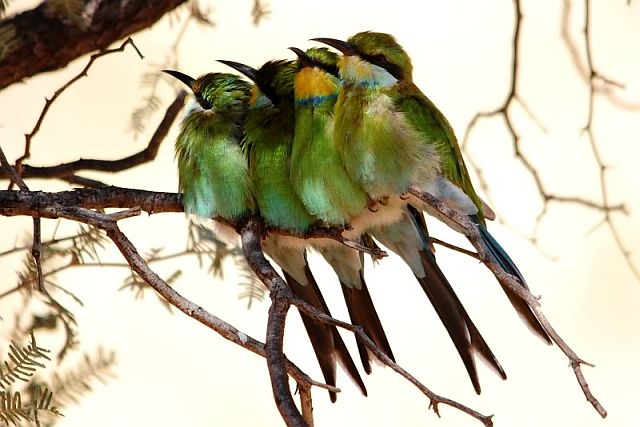
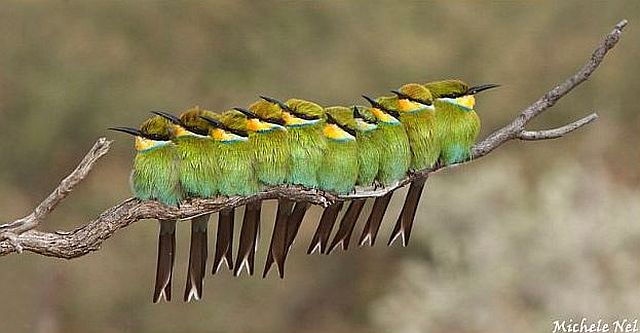 © Michele Nel
© Michele Nel
They can be observed singly or in pairs with flocks in winter numbering up to 30 birds. The roost in groups of around 10 birds tightly packed on branches in leafy trees.
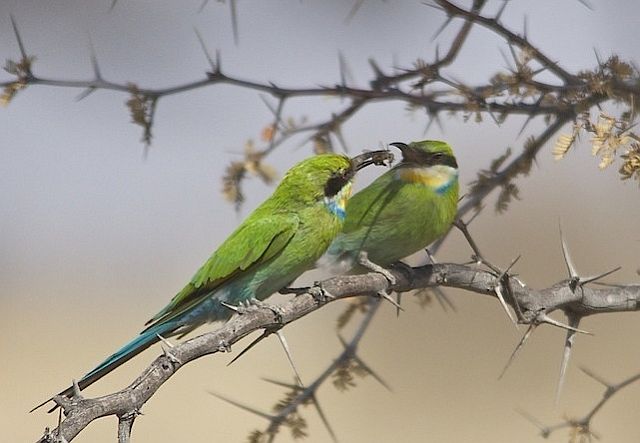 © ExFmem
© ExFmem
The male offers food to the female as nuptial gift.
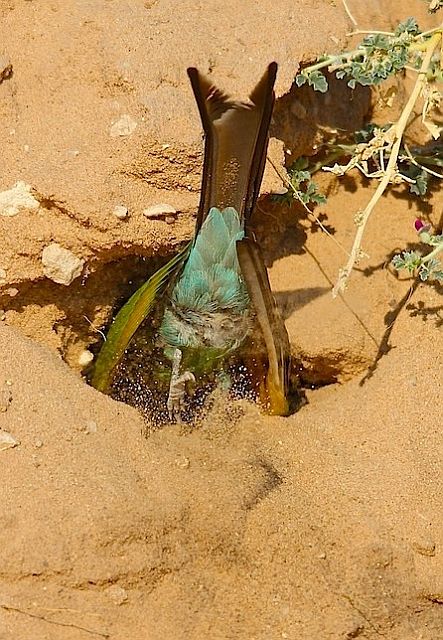 © ExFmem
© ExFmem
Excavating the nest tunnel
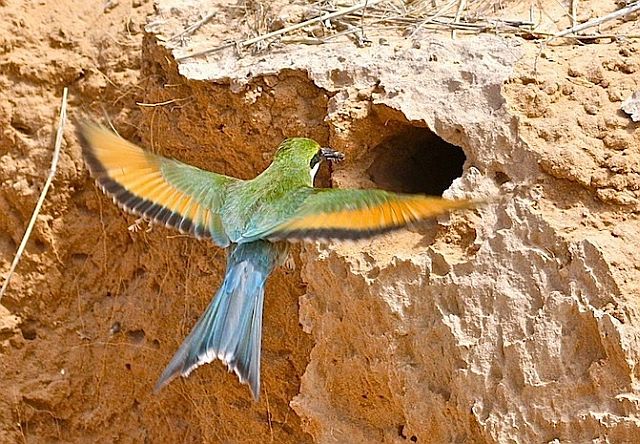 © ExFmem
© ExFmem
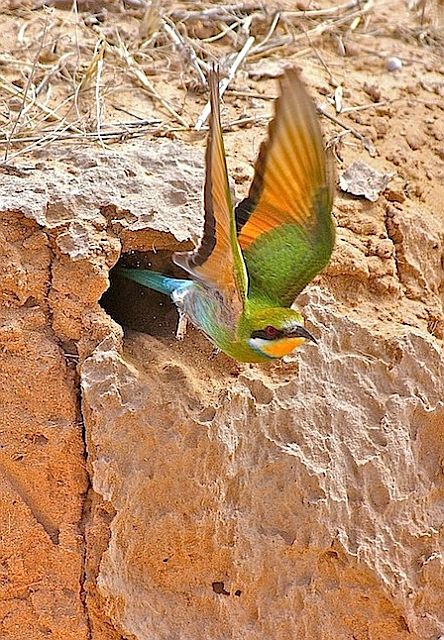 © ExFmem
© ExFmem
Links:
Sabap2: http://sabap2.adu.org.za/spp_summary.ph ... §ion=3
NEWMAN'S VOELS VAN SA (8ste UIT)
Hockey, P.A.R. 1996. Africa’s bee-eaters: a guide to their identification. Africa - Birds & Birding 1(3):59-63.


 © Michele Nel
© Michele NelThey can be observed singly or in pairs with flocks in winter numbering up to 30 birds. The roost in groups of around 10 birds tightly packed on branches in leafy trees.
 © ExFmem
© ExFmemThe male offers food to the female as nuptial gift.
 © ExFmem
© ExFmemExcavating the nest tunnel
 © ExFmem
© ExFmem © ExFmem
© ExFmemLinks:
Sabap2: http://sabap2.adu.org.za/spp_summary.ph ... §ion=3
NEWMAN'S VOELS VAN SA (8ste UIT)
Hockey, P.A.R. 1996. Africa’s bee-eaters: a guide to their identification. Africa - Birds & Birding 1(3):59-63.
God put me on earth to accomplish a certain amount of things. Right now I'm so far behind that I'll never die.
Little Bee-eater
444. Little Bee-eater Merops pusillus (Kleinbyvreter)
Order: Coraciiformes. Family: Meropidae
Description
The smallest Bee-eater at 15-17 cm long. Green back with orange-yellow underparts. Vivid yellow throat with wide, black gorget, turning orange on the breast. Has a thin whitish line between the gorget and throat. Black mask with red eye and short, powder blue eyebrow. Tail green with rufous at the edges and broad black tip. In flight shows rufous buff wings with black trailing edges. Legs and feet are dark grey. The sexes are alike.
Juvenile lacks gorget, and has faintly streaked breast.
Similar species: Confusion only likely with Swallow-tailed Bee-eater, but has black (not blue) gorget, buff (not green) belly and almost square orange/green tail.
Distribution
Across sub-Saharan Africa; in southern Africa it is common in northern Namibia, Botswana, Zimbabwe, Mozambique and north-eastern South Africa.
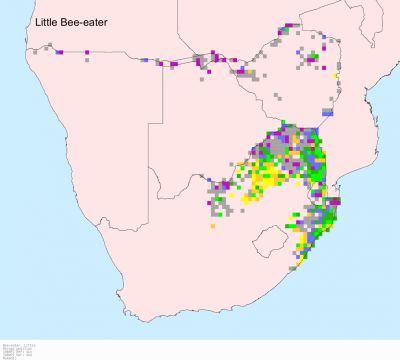
Habitat
Dry and moist savanna, partly dry marshes, lake shores, riverbanks, farmland and grassy clearings in forests.
Diet
Their diet includes insects, especially bees, wasps and hornets, which are caught on the wing. The sting is removed by hitting the insect on a hard surface.
Breeding
They are monogamous and are solitary nesters, constructing an unlined nest at the end of a tunnel burrowed into a sandy bank, or into the sand above an Aardvark hole. Both sexes excavate the 0.5-1.3 m long tunnel, ending in a 10 cm wide egg chamber. Egg-laying season is from August-February, peaking from September-December. 2 to 6 spherical white eggs are laid in unlined nest cavity. Both the male and the female incubate the eggs for about 18-20 days. The chicks stay in the nest for 23-24 days, becoming fully independent several weeks later.
The nest may be parasitized by the Greater honeyguide.
Call
The Little Bee-eater calls with a soft seep-seep. Listen to Bird Call.
Status
Locally common resident, nomadic in non-breading season; not gregarious and usually in pairs or small family groups. Pairs remain together year-round.
Order: Coraciiformes. Family: Meropidae
Description
The smallest Bee-eater at 15-17 cm long. Green back with orange-yellow underparts. Vivid yellow throat with wide, black gorget, turning orange on the breast. Has a thin whitish line between the gorget and throat. Black mask with red eye and short, powder blue eyebrow. Tail green with rufous at the edges and broad black tip. In flight shows rufous buff wings with black trailing edges. Legs and feet are dark grey. The sexes are alike.
Juvenile lacks gorget, and has faintly streaked breast.
Similar species: Confusion only likely with Swallow-tailed Bee-eater, but has black (not blue) gorget, buff (not green) belly and almost square orange/green tail.
Distribution
Across sub-Saharan Africa; in southern Africa it is common in northern Namibia, Botswana, Zimbabwe, Mozambique and north-eastern South Africa.

Habitat
Dry and moist savanna, partly dry marshes, lake shores, riverbanks, farmland and grassy clearings in forests.
Diet
Their diet includes insects, especially bees, wasps and hornets, which are caught on the wing. The sting is removed by hitting the insect on a hard surface.
Breeding
They are monogamous and are solitary nesters, constructing an unlined nest at the end of a tunnel burrowed into a sandy bank, or into the sand above an Aardvark hole. Both sexes excavate the 0.5-1.3 m long tunnel, ending in a 10 cm wide egg chamber. Egg-laying season is from August-February, peaking from September-December. 2 to 6 spherical white eggs are laid in unlined nest cavity. Both the male and the female incubate the eggs for about 18-20 days. The chicks stay in the nest for 23-24 days, becoming fully independent several weeks later.
The nest may be parasitized by the Greater honeyguide.
Call
The Little Bee-eater calls with a soft seep-seep. Listen to Bird Call.
Status
Locally common resident, nomadic in non-breading season; not gregarious and usually in pairs or small family groups. Pairs remain together year-round.
Dewi
What is the good of having a nice house without a decent planet to put it on? (H D Thoreau)
What is the good of having a nice house without a decent planet to put it on? (H D Thoreau)
Little Bee-eater Photos
444. Little Bee-eater Merops pusillus
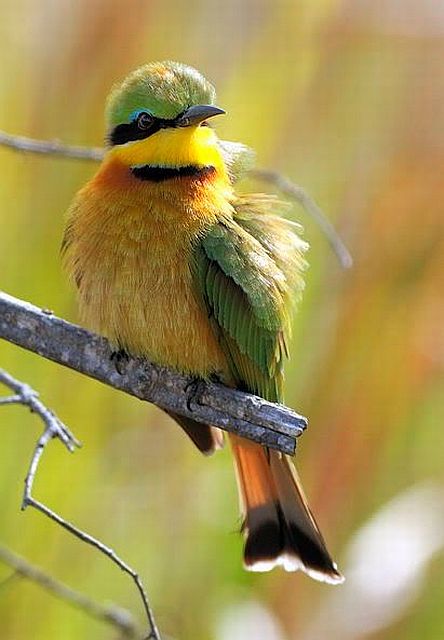
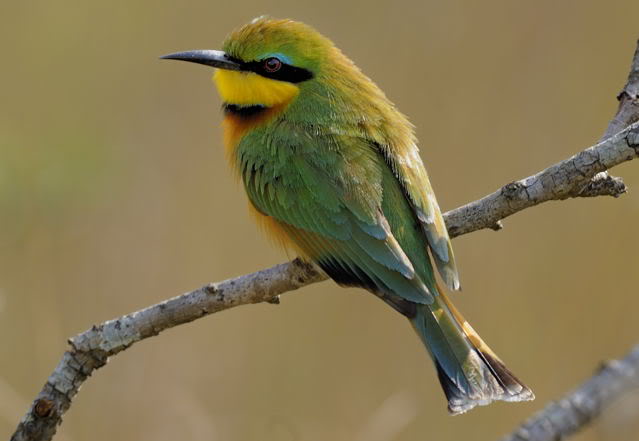
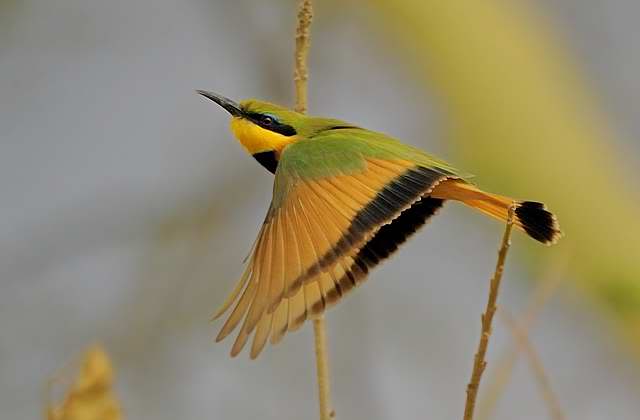
S56, Kruger National Park
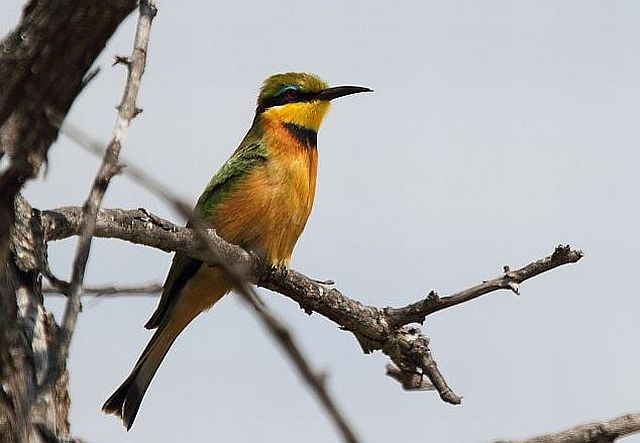 © Sharifa
© Sharifa
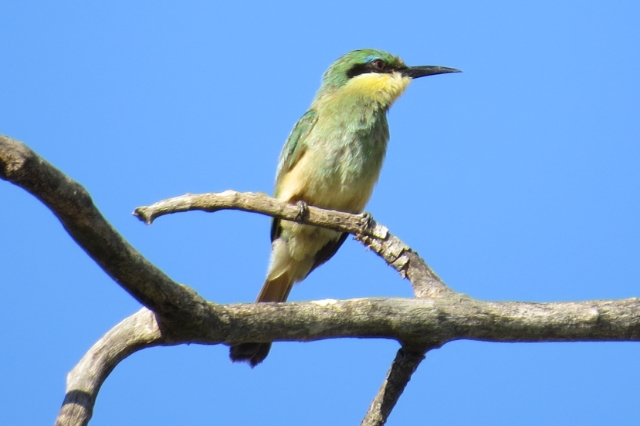 © Tina
© Tina
Juvenile, Kruger National Park, H4-1
Links:
http://sabap2.adu.org.za/species_info.p ... #menu_left
http://www.fitzpatrick.uct.ac.za/africa ... )59-63.pdf



S56, Kruger National Park
 © Sharifa
© Sharifa © Tina
© TinaJuvenile, Kruger National Park, H4-1
Links:
http://sabap2.adu.org.za/species_info.p ... #menu_left
http://www.fitzpatrick.uct.ac.za/africa ... )59-63.pdf
Dewi
What is the good of having a nice house without a decent planet to put it on? (H D Thoreau)
What is the good of having a nice house without a decent planet to put it on? (H D Thoreau)
- Sprocky
- Posts: 7110
- Joined: Sat May 19, 2012 12:29 pm
- Country: South Africa
- Location: Grietjie Private Reserve
- Contact:
White-fronted Bee-eater
443. White-fronted Bee-eater Merops bullockoides (Rooikeelbyvreter)
Order: Coraciiformes. Family: Meropidae
Description
Sexes alike, only bee-eater in region with red/white throat combination.
Green upperparts. Cinnamon underparts. Black mask. White forehead. Bright red throat. Square tail. Dark trailing edge to wings, visible in flight.
Distribution
Endemic to Africa, occurring from Gabon and Uganda south to southern Africa, where it is locally common in the Caprivi Strip (Namibia), northern and south-eastern Botswana, Zimbabwe, Mozambique, Swaziland and north-eastern and central South Africa.
Habitat
It is often associated with riverbanks and eroded gullies, as they are used as nesting sites. It generally prefers wooded grasslands, bushy pastures, broad-leaved and mixed woodlands, especially with nearby watercourses.
Diet
Exclusively flying insects, doing most of its hunting from a perch. Once prey is located, it descends to grab the insect before returning to its perch to swallow it. It also pursues prey aerially, sometimes ascending to hundreds of metres above the ground.
Breeding
Monogamous, strongly gregarious colonial nester. It has one of the most complicated societies of all birds, with each colony comprising a number of groups, known as clans. Each clan contains 3-6 'families', each containing one breeding pair and 1-5 helpers. Although a number of clans live in one colony, each has its own feeding territory, which they it defends vigorously from other clans. The helpers are usually the offspring of the breeding pair, helping with incubation and raising of the chicks. Interestingly, 9-12% of the chicks are not related to either one or both parents. If one parent is not related, it is because one of the parents copulated with a bird usually outside the family group - this is known as 'extra-pair copulation'. If both parents are not related, it is due to parasitism, where an unpaired female lays eggs in a breeding pair's nest, sometimes destroying any existing eggs which are not her own - this is known as intra-specific parasitism. The nest is built by both sexes and sometimes a helper, consisting of a tunnel 1m long, ending in an oval chamber. The burrow is usually dug into riverbanks or gullies by moving sand with its bill or, if it finds a more serious obstacle, using a bicycling action with its feet. Egg-laying season is normally in early summer, from August to November. It lays 2-5 eggs, with parasitism within the species also recorded, where an unpaired female lays its egg in a breeding pair's nest. It waits for the nest owner's absence, removing any existing eggs before laying its own. These chicks are raised normally, as there is no way that the adoptive parents can know whether they are their own. Incubation lasts roughly 21 days, with both parents and helpers participating. The chicks stay in the nest for 20-28 days, leaving before they have fully learnt to hunt. They are taught by their parents how to hunt insects, after which some juveniles disperse while others remain to help with the rearing of the next generation.
Call
Nasal gaaaa or gaaauuu. Listen to Bird Call.
Status
Locally common resident, with some local movements in non-br season.
Order: Coraciiformes. Family: Meropidae
Description
Sexes alike, only bee-eater in region with red/white throat combination.
Green upperparts. Cinnamon underparts. Black mask. White forehead. Bright red throat. Square tail. Dark trailing edge to wings, visible in flight.
Distribution
Endemic to Africa, occurring from Gabon and Uganda south to southern Africa, where it is locally common in the Caprivi Strip (Namibia), northern and south-eastern Botswana, Zimbabwe, Mozambique, Swaziland and north-eastern and central South Africa.
Habitat
It is often associated with riverbanks and eroded gullies, as they are used as nesting sites. It generally prefers wooded grasslands, bushy pastures, broad-leaved and mixed woodlands, especially with nearby watercourses.
Diet
Exclusively flying insects, doing most of its hunting from a perch. Once prey is located, it descends to grab the insect before returning to its perch to swallow it. It also pursues prey aerially, sometimes ascending to hundreds of metres above the ground.
Breeding
Monogamous, strongly gregarious colonial nester. It has one of the most complicated societies of all birds, with each colony comprising a number of groups, known as clans. Each clan contains 3-6 'families', each containing one breeding pair and 1-5 helpers. Although a number of clans live in one colony, each has its own feeding territory, which they it defends vigorously from other clans. The helpers are usually the offspring of the breeding pair, helping with incubation and raising of the chicks. Interestingly, 9-12% of the chicks are not related to either one or both parents. If one parent is not related, it is because one of the parents copulated with a bird usually outside the family group - this is known as 'extra-pair copulation'. If both parents are not related, it is due to parasitism, where an unpaired female lays eggs in a breeding pair's nest, sometimes destroying any existing eggs which are not her own - this is known as intra-specific parasitism. The nest is built by both sexes and sometimes a helper, consisting of a tunnel 1m long, ending in an oval chamber. The burrow is usually dug into riverbanks or gullies by moving sand with its bill or, if it finds a more serious obstacle, using a bicycling action with its feet. Egg-laying season is normally in early summer, from August to November. It lays 2-5 eggs, with parasitism within the species also recorded, where an unpaired female lays its egg in a breeding pair's nest. It waits for the nest owner's absence, removing any existing eggs before laying its own. These chicks are raised normally, as there is no way that the adoptive parents can know whether they are their own. Incubation lasts roughly 21 days, with both parents and helpers participating. The chicks stay in the nest for 20-28 days, leaving before they have fully learnt to hunt. They are taught by their parents how to hunt insects, after which some juveniles disperse while others remain to help with the rearing of the next generation.
Call
Nasal gaaaa or gaaauuu. Listen to Bird Call.
Status
Locally common resident, with some local movements in non-br season.
Sometimes it’s not until you don’t see what you want to see, that you truly open your eyes.
- Sprocky
- Posts: 7110
- Joined: Sat May 19, 2012 12:29 pm
- Country: South Africa
- Location: Grietjie Private Reserve
- Contact:
White-fronted Bee-eater Photos
443. White-fronted Bee-eater Merops bullockoides
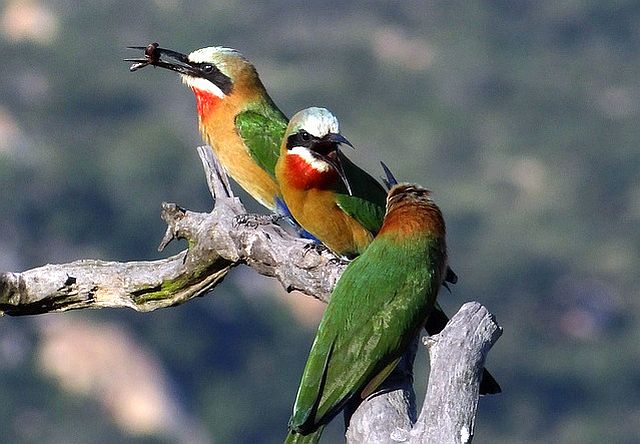 © Twigga
© Twigga
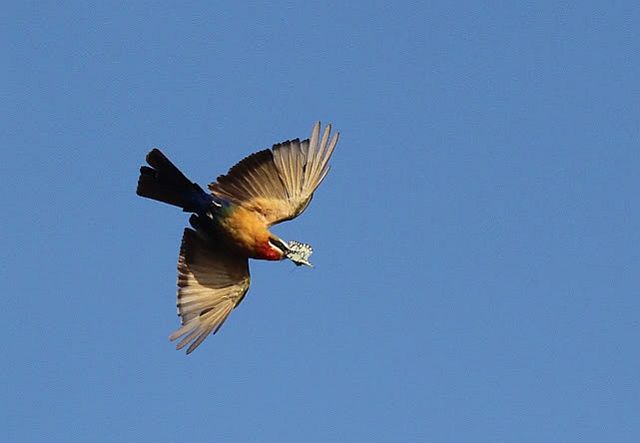 © leachy
© leachy
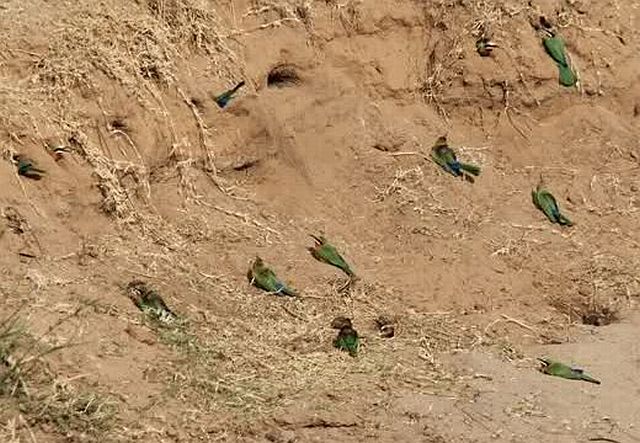 © pooky
© pooky
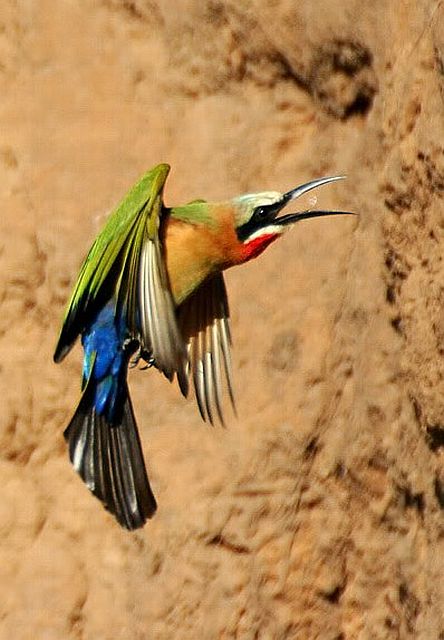 © leachy
© leachy
Links:
Species text Sabap1
Sabap2
Hockey, P.A.R. 1996. Africa’s bee-eaters: a guide to their identification. Africa - Birds & Birding 1(3):59-63.
 © Twigga
© Twigga © leachy
© leachy © pooky
© pooky © leachy
© leachyLinks:
Species text Sabap1
Sabap2
Hockey, P.A.R. 1996. Africa’s bee-eaters: a guide to their identification. Africa - Birds & Birding 1(3):59-63.
Sometimes it’s not until you don’t see what you want to see, that you truly open your eyes.
- Amoli
- Posts: 6032
- Joined: Fri Jun 01, 2012 4:30 am
- Country: South Africa
- Location: Kempton Park
- Contact:
Blue-cheeked Bee-eater
440. Blue-cheeked Bee-eater Merops persicus (Blouwangbyvreter)
Order: Coraciiformes. Family: Meropidae
Description
Length: 27-31 cm. Wingspan: 46-49 cm. Weight: 38-50 g. It is predominantly green; its face has blue sides with a black eye stripe, and a yellow and brown throat; the beak is black.
Flight: Blue-cheeked Bee-eater pursues preys by flying rapidly from perch. It performs rapid wing beats, glides and abrupt twists. It has an agile flight.
Adult non-breeding is slightly duller overall.
Sexes are mostly alike but the tail-streamers of the female are shorter.
Juvenile is markedly duller and lacks elongated central tail feathers.
Similar species: Blue-cheeked Bee-eater differs markedly from European Bee-Eater in its predominantly bright green plumage and rufous-chesnut throat, with yellow only on chin. Elongated central tail feathers of adult are longer. It has longer, finer black bill, giving it a longer, more streamlined look than European. Narrower black face mask bordered above and below by pale bands frequently whitish-looking than bluish, gives it distinctive facial expression, even at a distance when colours are hard to see. In flight from below, look quite dark-throated, and underwings are much paler and obviously coppery overall with narrower, less obvious dark trailing edge.
Madagaskar bee-eater and Blue-cheeked bee-eater can be confused. Both have a predominantly brown throat with a yellowish chin (more obvious in Blue-cheeked Bee-eater), and both have a conspicuous black stripe through the eye. However, the crown colour is quite different: Blue-cheeked Bee-eater has a green crown and Madagaskar Bee-eater has a brown crown. Both have a pale area above and below the eyestripe, but in Blue-cheeked Bee-eater this is blue, whereas in Madagaskar Bee-eater it is off-white. The pale stripe below the eye of Blue-cheeked Bee-eater does not continue unbroken and of the same colour on to the chin, whereas it does in Madagaskar Bee-eater.
Distribution
Occurs across sub-Saharan Africa, largely excluding Sudan and northern DRC. This Palearctic migrant breeds in Eurasia and North Africa, and spends the nonbreeding season in the tropics and subtropics of sub-Saharan AfricaNorthern and sub Saharan Africa. The subspecies M. p. chrysocercus breeds on the fringes of the western Sahara and migrates to West Africa, whereas persicus breeds from the Nile Delta to the Caspian Sea in Kazakhstan.The nominate race spends the nonbreeding season in savanna habitats from southern Sudan and Ethiopia to subtropical South Africa, extending from Mozambique into northern KwaZulu-Natal, southeastern Zimbabwe and the Transvaal. Its strongholds in southern Africa lie in northern Botswana and the Caprivi Strip, and to a lesser extent the upper Limpopo catchment, it is very common in southern Mozambique.
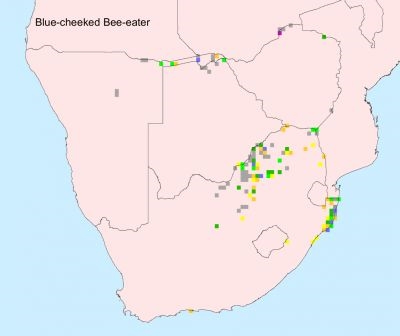
Habitat
Blue-cheeked Bee-eater breeds mainly in sand deserts near water fringed with bushes and acacia or tamarisks. It lives in open cultivation, with some trees and bushes, or dry uncultivated country with scattered bushes. Almost always found in close association with water in form of rivers, irrigation canals, lakes or marshes. In southern Africa, it generally prefers savanna, but it can also be found on open lake shores with reeds, wooded swamps and bushy grassland.
Movements and migrations
It is migratory, moving in small or large flocks mainly by day, passing on broad front often at considerable height. Palearctic breeding migrant, arriving in southern Africa from October-November and leaving for its Eurasian breeding grounds in the period from March-May.
Diet
Blue-cheeked Bee-eaters are insectivorous, eating mainly flying insects. They can eat dangerous insects such as bees, wasps and hornets which are rendered harmless before being eaten: the tail (and sting) of the insects is rubbed against the perch to express the venom and often the sting itself. Blue-cheeked Bee-Eater feeds by making long pursuit flights from perch, and even from the ground. It returns to perch to knock the prey and, if is a hymenoptera, to rub its tail.
Breeding
Blue-cheeked Bee-eater nests solitary or in loose colonies in sandy banks, on canal or ditch, low cliff and sandy mud plain. They make a burrow 1 to 3 metres long, depending of softness of soil, nearly straight, and in level-declining 15/20 degrees. The nesting-chamber is at the end of the burrow. Female lays 4 to 8 (usually six or seven) white eggs. Incubation lasts 23 to 26 days by both parents which also care the young together. The young fledge at about 23-26 days after hatching.
Call
Blue-cheeked Bee-eater’s call is a rapid, rippling trill priip or driip frequently repeated. The song is more disyllabic than European’s song, hoarser, less liquid, and shriller. Its call is slightly higher-pitched, but ending is slightly lower-pitched. Listen to Bird Call.
Status
Uncommon to locally common summer visitor. Blue-cheeked Bee-eater is not globally threatened. It is a common and widespread species. These bee-eaters are gregarious, nesting colonially in sandy banks. They feed and roost communally.
Order: Coraciiformes. Family: Meropidae
Description
Length: 27-31 cm. Wingspan: 46-49 cm. Weight: 38-50 g. It is predominantly green; its face has blue sides with a black eye stripe, and a yellow and brown throat; the beak is black.
Flight: Blue-cheeked Bee-eater pursues preys by flying rapidly from perch. It performs rapid wing beats, glides and abrupt twists. It has an agile flight.
Adult non-breeding is slightly duller overall.
Sexes are mostly alike but the tail-streamers of the female are shorter.
Juvenile is markedly duller and lacks elongated central tail feathers.
Similar species: Blue-cheeked Bee-eater differs markedly from European Bee-Eater in its predominantly bright green plumage and rufous-chesnut throat, with yellow only on chin. Elongated central tail feathers of adult are longer. It has longer, finer black bill, giving it a longer, more streamlined look than European. Narrower black face mask bordered above and below by pale bands frequently whitish-looking than bluish, gives it distinctive facial expression, even at a distance when colours are hard to see. In flight from below, look quite dark-throated, and underwings are much paler and obviously coppery overall with narrower, less obvious dark trailing edge.
Madagaskar bee-eater and Blue-cheeked bee-eater can be confused. Both have a predominantly brown throat with a yellowish chin (more obvious in Blue-cheeked Bee-eater), and both have a conspicuous black stripe through the eye. However, the crown colour is quite different: Blue-cheeked Bee-eater has a green crown and Madagaskar Bee-eater has a brown crown. Both have a pale area above and below the eyestripe, but in Blue-cheeked Bee-eater this is blue, whereas in Madagaskar Bee-eater it is off-white. The pale stripe below the eye of Blue-cheeked Bee-eater does not continue unbroken and of the same colour on to the chin, whereas it does in Madagaskar Bee-eater.
Distribution
Occurs across sub-Saharan Africa, largely excluding Sudan and northern DRC. This Palearctic migrant breeds in Eurasia and North Africa, and spends the nonbreeding season in the tropics and subtropics of sub-Saharan AfricaNorthern and sub Saharan Africa. The subspecies M. p. chrysocercus breeds on the fringes of the western Sahara and migrates to West Africa, whereas persicus breeds from the Nile Delta to the Caspian Sea in Kazakhstan.The nominate race spends the nonbreeding season in savanna habitats from southern Sudan and Ethiopia to subtropical South Africa, extending from Mozambique into northern KwaZulu-Natal, southeastern Zimbabwe and the Transvaal. Its strongholds in southern Africa lie in northern Botswana and the Caprivi Strip, and to a lesser extent the upper Limpopo catchment, it is very common in southern Mozambique.

Habitat
Blue-cheeked Bee-eater breeds mainly in sand deserts near water fringed with bushes and acacia or tamarisks. It lives in open cultivation, with some trees and bushes, or dry uncultivated country with scattered bushes. Almost always found in close association with water in form of rivers, irrigation canals, lakes or marshes. In southern Africa, it generally prefers savanna, but it can also be found on open lake shores with reeds, wooded swamps and bushy grassland.
Movements and migrations
It is migratory, moving in small or large flocks mainly by day, passing on broad front often at considerable height. Palearctic breeding migrant, arriving in southern Africa from October-November and leaving for its Eurasian breeding grounds in the period from March-May.
Diet
Blue-cheeked Bee-eaters are insectivorous, eating mainly flying insects. They can eat dangerous insects such as bees, wasps and hornets which are rendered harmless before being eaten: the tail (and sting) of the insects is rubbed against the perch to express the venom and often the sting itself. Blue-cheeked Bee-Eater feeds by making long pursuit flights from perch, and even from the ground. It returns to perch to knock the prey and, if is a hymenoptera, to rub its tail.
Breeding
Blue-cheeked Bee-eater nests solitary or in loose colonies in sandy banks, on canal or ditch, low cliff and sandy mud plain. They make a burrow 1 to 3 metres long, depending of softness of soil, nearly straight, and in level-declining 15/20 degrees. The nesting-chamber is at the end of the burrow. Female lays 4 to 8 (usually six or seven) white eggs. Incubation lasts 23 to 26 days by both parents which also care the young together. The young fledge at about 23-26 days after hatching.
Call
Blue-cheeked Bee-eater’s call is a rapid, rippling trill priip or driip frequently repeated. The song is more disyllabic than European’s song, hoarser, less liquid, and shriller. Its call is slightly higher-pitched, but ending is slightly lower-pitched. Listen to Bird Call.
Status
Uncommon to locally common summer visitor. Blue-cheeked Bee-eater is not globally threatened. It is a common and widespread species. These bee-eaters are gregarious, nesting colonially in sandy banks. They feed and roost communally.
Pretoriuskop
Satara
Shingwedzi
20-30 Dec 2014
Satara
Shingwedzi
20-30 Dec 2014
- Amoli
- Posts: 6032
- Joined: Fri Jun 01, 2012 4:30 am
- Country: South Africa
- Location: Kempton Park
- Contact:
Blue-cheeked Bee-eater Photos
440. Blue-cheeked Bee-eater Merops persicus (Blouwangbyvreter)
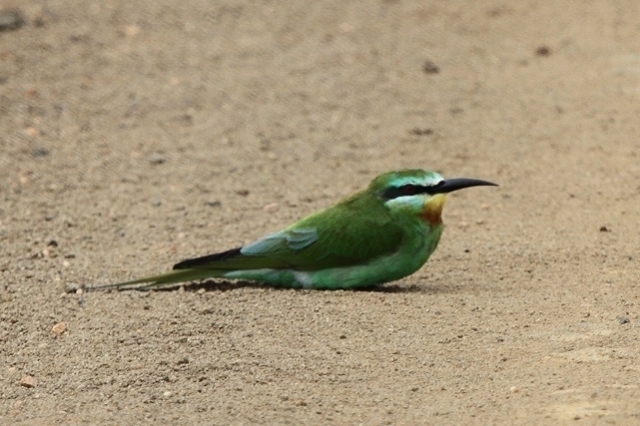 © Tina
© Tina
iSimangaliso
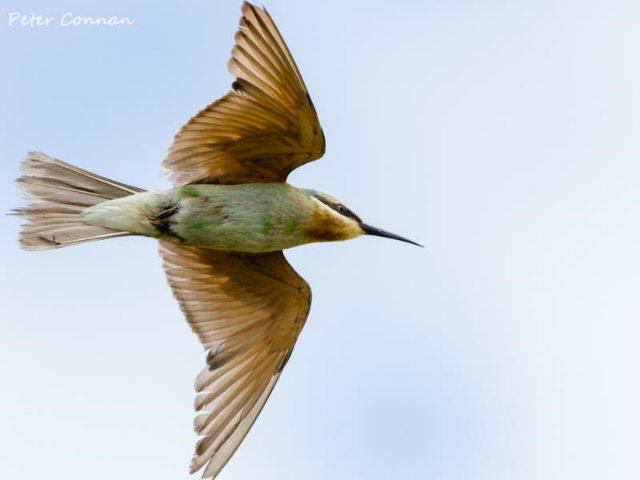 © Peter Connan
© Peter Connan
Maphelane, iSimangaliso Wetland Park, KwaZulu-Natal
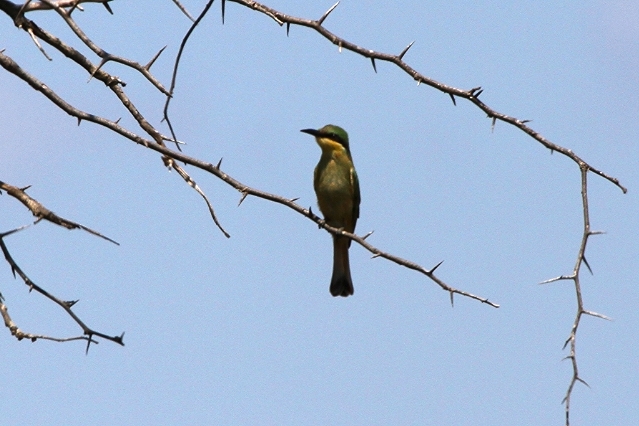 © Tina
© Tina
Juvenile, Skukuza, Kruger National Park
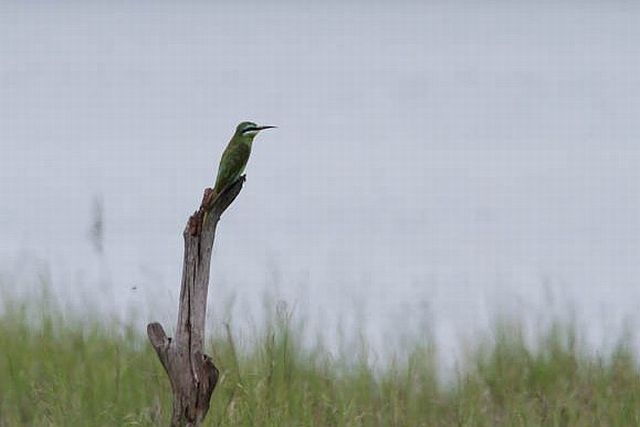 © Super Mongoose
© Super Mongoose
Vaalkop Dam Nature Reserve, North West Province, South Africa
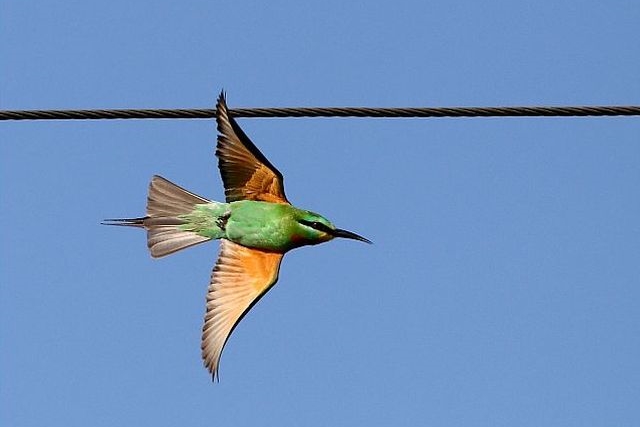 © Duke
© Duke
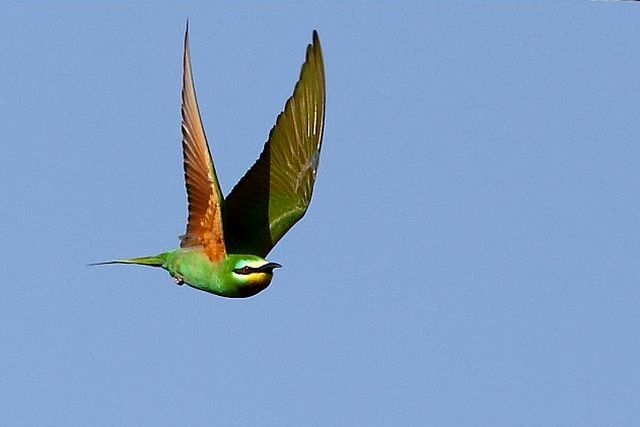 © Duke
© Duke
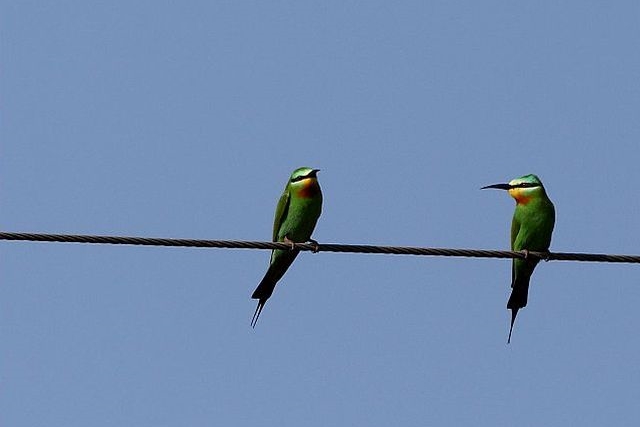 © Duke
© Duke
iSimangaliso
Links:
Species Text Sabap1
Sabap2
Hockey, P.A.R. 1996. Africa’s bee-eaters: a guide to their identification. Africa - Birds & Birding 1(3):59-63.
 © Tina
© TinaiSimangaliso
 © Peter Connan
© Peter ConnanMaphelane, iSimangaliso Wetland Park, KwaZulu-Natal
 © Tina
© TinaJuvenile, Skukuza, Kruger National Park
 © Super Mongoose
© Super MongooseVaalkop Dam Nature Reserve, North West Province, South Africa
 © Duke
© Duke © Duke
© Duke © Duke
© DukeiSimangaliso
Links:
Species Text Sabap1
Sabap2
Hockey, P.A.R. 1996. Africa’s bee-eaters: a guide to their identification. Africa - Birds & Birding 1(3):59-63.
Pretoriuskop
Satara
Shingwedzi
20-30 Dec 2014
Satara
Shingwedzi
20-30 Dec 2014


